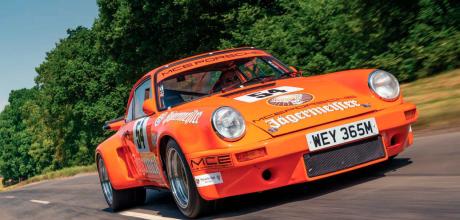Road racer street-legal 330bhp Porsche 911 RSR Replica
Air-cooled Porsche restoration specialist, Mike Champion, was so fascinated by the Jägermeister liveried 934 and Carrera RSRs prominent in the 1970s and 1980s, he created his own version: a road-legal RSR...
Words Johnny Tipler
Photography Dan Sherwood
OUR FAVOURITE TIPPLE
Mike Champion’s RSR 3.0 replica
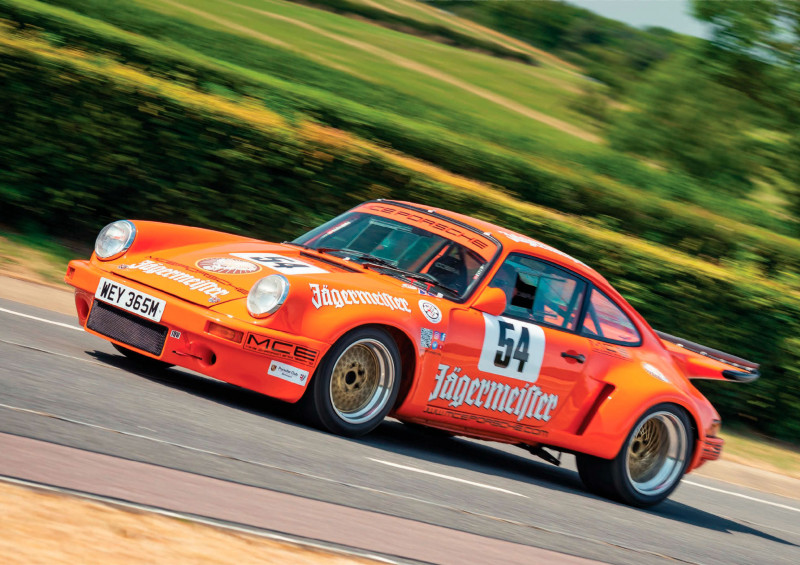
Jägermeister. There’s a certain ring to it. There’s also the brand’s Germanic script and famous stag logo. As for the colour, who doesn’t love an orange 911? Tasty! It appealed so much to independent marque specialist, Mike Champion, he created the very Carrera RSR 3.0 replica you see on these pages.
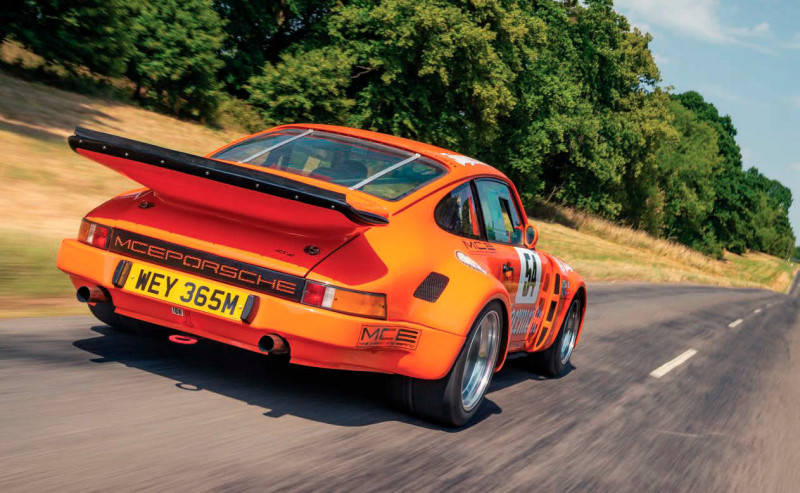
THE CAR ROLLS ON BBS SPLIT RIMS, BUILT TO MIKE’S OWN SPECIFICATION TO ENSURE THE OFFSET HE WANTED
Mike owns MCE Porsche, an everything-under- one-roof shop specialising in classic Porsche restoration. He campaigned the car in last season’s Porsche Club Motorsport 911 Challenge and has since rebuilt the engine. Unlike the majority of other 911s competing, however, this one travels to circuits and back under its own power — Mike has built a roadlegal RSR! Incongruous? He finds driving the car to tracks more convenient than trailering. RSR. We’re talking about big-time race cars. Back in the day, the Carrera RSR 3.0 was Porsche’s pragmatic response to shifting FIA regulations, because in 1973, the first turbocharged Carrera RSRs were quick enough to rival the Matra, Mirage and Ferrari prototypes for outright wins, as happened in the 1973 Targa Florio. In 1974, the normally aspirated Carrera RSR 3.0 basked in the reflected glory of the works RSR Turbos and formed the bedrock of the European GT Championship for the next two seasons. With sights set on 1975, when the World Championship for Makes would be formulated for production-based race cars, Porsche concentrated on developing the turbocharged 934 and 935 for Group 5, while customer teams flew the flag in Groups 3, 4 and IMSA categories, fielding the Carrera RSR 3.0. Although dominant in the European GT series, the model was by no means a highvolume production Porsche — the Weissach competitions department built just 109 units in both RS (road trim) and RSR (race trim), split between fifty-six road-going models and fiftythree race cars.
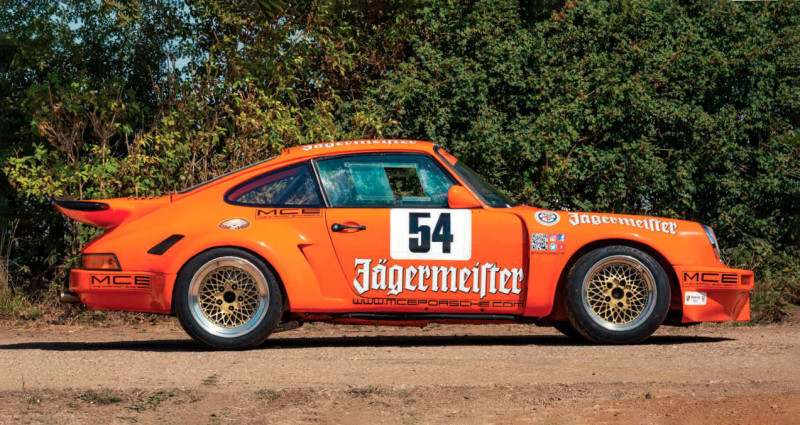
THE DRINKS BRAND SPONSORED SEVERAL TEAMS IN PERIOD, INCLUDING KREMER RACING AND MAX MORITZ
The first fifteen Carrera RSR 3.0s were despatched to North America for the International Race of Champions (IROC) series, which starred leading drivers from Indycar, NASCAR, TransAm, Can-Am and Formula One. Invited aces raced identically prepared 911s. Interestingly, the IROC RSRs were the first racing Porsches to flaunt then new impact-bumper styling. In this respect, the Carrera RSR 3.0 was a quantum leap from the preceding Carrera RS 2.7 and the older 911’s mild wheel arch flares and ducktail spoiler. The Carrera RSR 3.0’s pumped-up bodyshell was typified by bulging quarters, lighter-gauge steel, thinner glass and minimal sound-deadening, plus a new front bonnet and engine lid, from which sprouted a new horizontal wing, known as a whale tail. The coherently integrated front airdam and valance was different from the series production cars, with its frontal opening for the oil cooler and paired brake cooling ducts on either side. Two types of whale tail were available: a smaller version equipped with protective rubber lip for road use, and for racing, the bigger IROC-style wing with its additional cooling vent, extending beyond the rear of the car’s bodywork.
JUICY UPGRADES
Compared to the flat-six powering the earlier Carrera RSR 2.8, the three-litre boxer featured a larger bore and a more forgiving aluminium crankcase than the magnesium componentry on the smaller displacement unit. The three-litre engine was also equipped with twinplug ignition, reprofiled camshafts and made use of 10:3.1 compression ratio, contributing to power output of near 330bhp at 8,000rpm and close to 232lb-ft torque at 6,500rpm. While you’d be right to think enhanced power was a major plus point on the track, the biggest benefit to come from the new specification was improved reliability. Nevertheless, with weight tipping scales at just nine hundred kilos, the Carrera RSR 3.0 was capable of hitting top speed just shy of an astonishing 180mph.
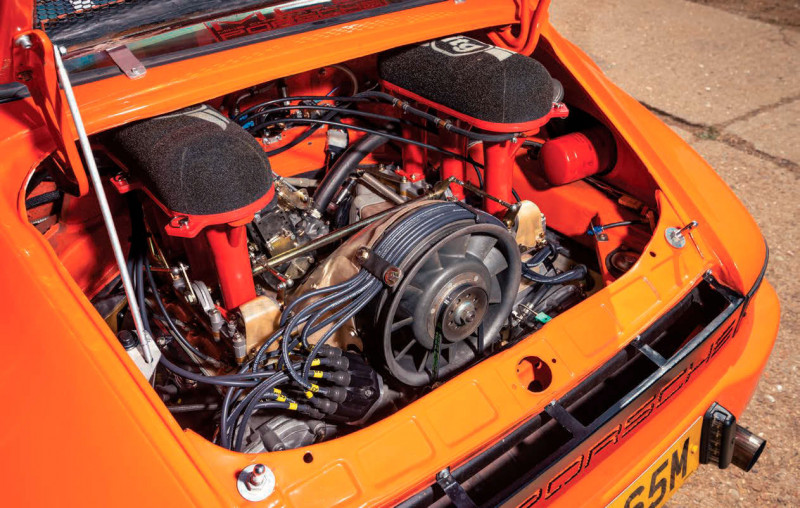
THE ORIGINAL JÄGERMEISTER CARRERA RSR 3.0, CARRYING RACING NUMBER FIFTY-FOUR, WAS DRIVEN BY ECKHARD SCHIMPF
The brakes were sourced from the 917, as were the RSR 3.0’s superb centre-lock wheels, measuring ten and a half inches of girth at the front, fourteen at the back. Helping to keep weight to a minimum, the cabin was stripped of all but the bare essentials, the windows were made from polycarbonate and fibreglass was used to construct the bumpers, engine lid and frunk. Exaggerated rear wheel arches accommodated intake apertures to cool those powerful 917 anchors, which sat ahead of coil springs, adopted in place of the traditional torsion bar arrangement. Having said all this, it’s important to remember the Carrera RSR 3.0 was built around a standard production 911 shell, a requirement for homologation purposes.
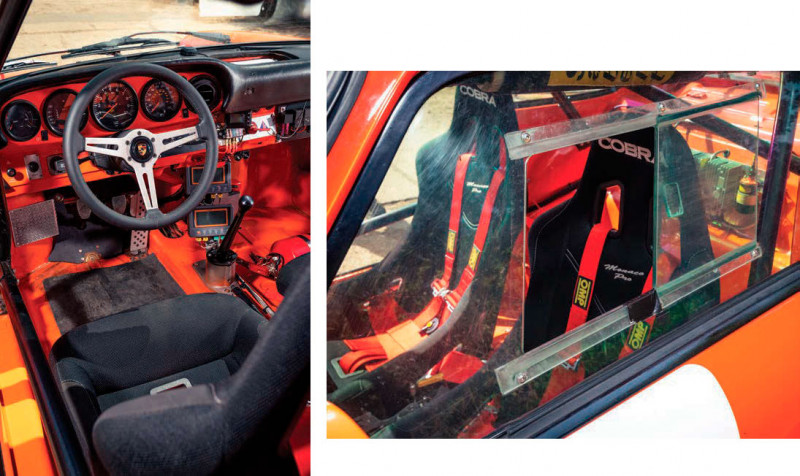
Mike is in good company — when I interview racing drivers, I usually ask them what their favourite Porsche race car is, and, almost without exception, the answer is the Carrera RSR 3.0. Derek Bell told me how this 911 felt compared with its successors, the turbocharged 934 and 935. “In 1976, I raced a 934 and an RSR for the same team, Max Moritz Racing, in the same race at the Nürburgring, which was rather exciting because I got out of one 911 and hopped into the other. I was happy enough in the 934, which was turbocharged, but the normally aspirated Group 5 RSR proved much more fun to drive than the 934, which was such a handful when allthe power came in, even with those massive wheels and tyres at the back.”
And what about Mike’s zesty RSR replica? He took it under his wing around Christmas 2019 as an unfinished project, acquired from where it had been residing in Denmark. “It had been raced in Europe as an RS, and the owner, who’s a very keen classic car race enthusiast with a couple of early Porsches and a Mk1 Escort in his garage, started the conversion to RSR spec. Soon after, other projects took priority. He’d taken care of the majority of the bodywork and he’d swapped the old RS magnesium case engine to an aluminium case unit, following up with a season of racing. The engine was tired, but it was running, meaning I could wheel the car around my workshop.” The chassis hadn’t been modified to RSR specification, although a Heigl roll cage and a fifty-litre racing fuel tank were in place.
The car was originally an impact-bumper 911 from 1976, galvanised, though Mike reckons there’s nothing factory-original left, other than the shell. His target was to race in 2021’s 911 Challenge. Porsche Club Motorsport administrators, Chris Pruden and Mandy Sear, had just launched the series and were scouting for willing participants in charge of air-cooled 911s. All standard cars from 1965 to 1989 are eligible to compete, though to satisfy demand from owners of later air-cooled cars, Chris soon announced plans to introduce an open class for 964s, as well as heavily modified 911s. “Chris’s vision was to reprise the era of classic 911 racing and get air-cooled cars back on the grid,” Mike muses. “I thought, okay, I’ll go for that, because it’s surprisingly difficult to find a series to properly race these cars against one another. Then it was a case of building a 911 to compete in around other workshop commitments. I did so across weekends and evenings, finding slots in the workshop during 2020, through periods of lockdown, to get the car ready for the inaugural 911 Challenge season.”
During this period, Mike performed the chassis build, including installing a new wiring harness, which included working lights, a rational ignition system, indicators and wipers, all to ensure the car could be road-legal. “I know what an RSR needs to be capable of, which is why there was a lot of work on the suspension geometry,” he continues. “The wheel offsets on an RSR are greater, the wheel sizes are different and need to be compliant with tyre regulations.” A bigger brake package was required, as well as 935-specification front suspension, which provided full flexibility and provision for adjustment of camber, offset, kingpin angle and tracking. Due to the fact the car needed to be FIA-compliant, the only changes Mike could make at the back end had to be in accordance with RSRs in period. “The rear arms had to be short versions in steel at the revised mounting points for the RSR, thereby giving the car the proper rear suspension arc and travel for the lower driveline height, as well as the agreeable rear camber control RSR geometry gives you.” He had to update the fuel system, because the aforementioned fifty-litre tank was nowhere near big enough for the 911 Challenge’s hour-long races. “A larger fuel cell went in to handle the amount of petrol the car would be consuming. I also installed aLifeline fire safety system, ignition cut-off switches, an AZ Instruments digital data-logging system, rear window straps, Cobra Monaco Pro bucket seats, OMP safety harnesses and a WEVO shift mechanism. That’s pretty much how I raced the car last year, with no changes to the engine, a result of simply running out of time before the season started. That said, I was keen to see how the engine was behaving and get a feel for the car’s balance. Effectively, it was a shakedown across a couple of races, without having to go in for a full engine build.”
After an absence from racing of around ten years, Mike was happy enough just to be in the mix. There were no podiums nor high placings, mainly because he found himself up against RS-badged 964s. “We’re talking twenty years of advances in technology over my car,” he laughs, “and in the open class, there were no FIA constraints. I was up against 3.8-litre 911s running more advanced chassis. These cars could get around corners much quicker and could accelerate faster. I was never going to get a good placing against them. Then again, I wasn’t going to start throwing money at the car to make it competitive against 964s, or even the modified SCs competing, because this would mean risking my 911 no longer being FIA compliant, a hard sticking point as far I was concerned. I was building an RSR replica because I wanted to get RSR racing experience. This meant sticking with the technology of the day, as it was in period, and sticking with FIA regulations.”
Due to the fact the car is road-legal, Mike could drive it to and from race circuits, as I did with my Alfa Romeo GTV6 when I ran in the AROC series in 1989 and 1990. “It did depend on where the track was,” he reveals. “I trailered it to tracks far afield, simply because the car consumes quite a lot of fuel. It doesn’t make sense to spend two or three hours driving this 911 up to, say, Snetterton or Croft from my base near Banbury, especially when I’ve got a stack of tools and other gear to carry. When I raced at Silverstone, which is literally fifteen minutes up the road from home, I drove it to the circuit and back again. That was one of the main reasons why I wanted to make the car road-legal, so I could drive to Silverstone, it being my local circuit. Additionally, when you’re conducting drivability calibration and chassis build, it’s useful to be able to take the car onto the road for testing.” It’s the same with dyno sessions. “There are a couple of rolling roads I use within a fifteen-minute drive of home. It’s so much easier to drive the car to the site and strap it down, rather than faff around with a van and towing trailer.”
Mike knows a thing or two about engine building and tuning. MCE (that’s Mike Champion Engineering, in case you hadn’t already guessed) was established in 2012, following many years he spent working for some of the most respected names in the automotive world. “I left school not long after my eighteenth birthday and began an apprenticeship learning car bodywork repair andpaint,” he tells us. “I then moved onto fabrication and welding, developing my practical skills all the while, but even as a young child, I was fascinated by how things work, the technology behind them and what challenges their creators faced during the development process. This curiosity continued with me through my formative years and into adulthood, leading me to embark on a four-year degree in automotive engineering. Benefiting from work placement in the industry, I passed the course with firstclass honours.”
INTO THE BIG LEAGUE
An invitation to join Tom Walkinshaw Racing (TWR) followed. Founded in 1976 by racing driver, Tom Walkinshaw, TWR took on the factory touring car programmes for Mazda and Rover, but is most famous for its work with Jaguar, beating Porsche to the 1988 World Sportscar Championship constructors and drivers titles with the XJR-9. Dressed in the now iconic purple Silk Cut livery, the seven-litre, V12-propelled sports-prototype took the win at the 1988 24 Hours of Le Mans (the fifth round of the championship), marking the first time since 1980 Porsche hadn’t secured overall top honours at Circuit de la Sarthe. Jaguar and TWR would win the daylong French endurance race again in 1990. It would be 1994 before a Porsche repeated the feat of taking firstplace overall. “Tom was trying to promote TWR as a rival for Porsche’s motorsport and engineering departments,” Mike recalls. “Accordingly, we offered a huge amount of in-house engineering expertise to world-renowned car brands, including Jaguar, obviously, but also Nissan, which commissioned TWR to take care of suspension work. SAAB was also a client, seeking assistance for further development of its range of turbocharged engines. Additionally, TWR developed and built the legendary midengined Renault Clio V6 Sport,” he adds, before revealing an interesting truth. “Porsche was always the benchmark, always the point of reference. We’d constantly be looking at how the German company’s engineers were doing things. More specifically, the 911 was held up as a prime example of engineering excellence, something to aspire to and a source of real inspiration. I remember thinking to myself, if Porsches are so good, why aren’t I working on those instead?!”
Purchase of a 993 gave him a taste of things to come, but a series of important jobs at major automotive brands preceded the forming of his own Porsche business. “After my time at TWR, I spent three years working on engine development at Jaguar, before joining Cosworth, where I stayed for seven years, managing race engine programmes for industry clients, including Aston Martin, and developing variable valve timing concepts.” He was then invited to work for the Gaydon concern directly, before being pulled back to Jaguar to oversee complex chassis and suspension design projects, as well as complete vehicle testing. “I enjoyed all of these jobs, but I was unable to shake the desire to work on Porsche sports cars. When an opportunity to buy and resurrect a pair of derelict smithy buildings in Motorsport Valley presenteditself, I saw potential for a new home, as well as the opportunity to build workshop space enabling me to realise my dream of establishing a business conducting classic Porsche works, from minor servicing to full restoration exclusively for rear-engined models.”
Correctly configuring an RSR’s suspension is crucial. To this end, Mike’s car makes use of modified Bilstein dampers, altered because RSR suspension geometry demands modifications to the spindle and steering arm to be able to dial out bump steer. Wheel choice is interesting — the car rolls on custom-made BBS split rims, built to Mike’s own specification to ensure he could get the offset he wanted to accommodate the maximum tyre options and within the bodywork, given the steering and suspension geometry he’d set the car to. “I’ve got enough capability to dial-in suspension settings good for a generic track setting,” he tells us. “There’s a core level of tuning that says you can split a suspension set-up into road or track, but that a set-up that’s good for road is not going to be ideal for track, and vice versa. Beyond that, there’s a degree of adjustment good for a right-handed twisty circuit or an oval with long straights. You’ve also got diversification with different levels of fuel load, which varies during the length of a race. I was able to find a good track-biased setting I knew was going to be ideal for ninety-five percent of the tracks this car was ever going to be on, with the broad range of fuel loads that it was likely to be carrying, along with the known tyre specifications and the current engine capability.”
911 Challenge didn’t specify a control tyre, only that whatever rubber used needed to be a road tyre. The MSA rule book has an official list of approved road tyres. The Classic Sports Car Club (CSCC) use it as their bible for allowable treaded tyres, which are non-slicks or non- Cup slicks. Most teams are running Toyos. “That’s fine if you’re on a standard 911 chassis,” Mike reasons, “but the RSR addresses the balance issues of the 911 by putting tonnes of tread on the rear, a very old-school way of balancing traction capability, front to rear, based on weight distribution.”
There isn’t a road tyre that’s got suitable track width an RSR is happy with, though. “Race tyres are brilliant, because you can specify massive depth that will fit on a fifteen- or sixteen-inch rim, but as soon as you go to road tyres, you’re fairly constrained. And, of course, when your tyre choice is constrained, grip is constrained. Your chassis set-up therefore must be compatible with all of this, which is why I tuned my 911’s chassis for circuit racing, but with a road-biased tyre, even though it’s not the ideal choice for an RSR.” To really exploit an RSR, you really want to put racing slicks on it, get the rear tyre section up to as wide as possible and utilise the full power and turn-in capability of the car as it was originally engineered. Mike can always change the race series he participates in, of course. He’s got an FIA-homologated car eligible for national andinternational historic events run by the Historic Sports Car Club (HSCC), Peter Auto and Roadbook. These events include Le Mans Classic, Nürburgring Old Timer and Spa Six Hours. “That’s where this kind of 911 is happiest,” he says. “It’s also taking a long-term view about my intention for the car, to make it capable of taking part in international historic competition at FIA level, allowing it to race as RSRs did in period.”
It was time to bite the bullet and get serious with the flat-six. “It was clear that if I really wanted to get competitive and get up toward the front of the grid, then I was going to have to pull the engine and do a proper rebuild. This was my task after Silverstone last year. It took me through to May of this year to strip the unit, inspect it, re-specify the necessary parts, re-engineer and rebuild, including a conversion to slide throttles, an MCE custom-designed camshaft and valving, porting and exhaust changes to achieve a power output of 330bhp, matching the original RSRs in period. I’m constrained by three litres, effectively meaning the criteria for increased performance couldn’t come from displacement — it had to come from revs. As soon as you define as much, you know you’re going to need a lightweight valvetrain and other hardware changes to get to target power.”
Of all the liveries Mike could have selected for his RSR — Toblerone, Brumos, Vaillant, to name but three — he chose Jägermeister. “I quite like orange cars,” he beams. “If you’re going to have a loud, brash, full-on racing Porsche, it might as well be one that gets noticed. One of the things I love about early 911s is the brand’s safety colours philosophy. I’m keen on promoting cars in bright colours, because if they can be seen, the roads will be safer. I will do whatever is in my power to keep as many silver cars off the road as possible!” Jägermeister livery fits the bill exactly. “Martini graphics and some of the Kremer cars were very striking, but Jägermeister livery stands out to an even greater degree.”
The original Jägermeister Carrera RSR 3.0, carrying racing number fifty-four as per Mike’s car, was driven by Eckhard Schimpf. Between 1974 and 1977, Schimpf drove his RSR in selected 500km Championship rounds, plus domestic DARM races in Germany, sometimes solo, sometimes with co-drivers, most notably in 1976 at the Silverstone Six Hours, with superstars Jürgen Barth and Reinhold Jöst at his side. As for Jägermeister, the drinks brand sponsored several teams in period, including Kremer Racing and Max Moritz. Jägermeister Racing was, in fact, run by Schimpf himself, who in 2016, along with his son, Oliver, organised a reunion of the iconic orange race cars, including the very Carrera RSR 3.0 that he raced in eighty-four different events, notching up thirty-nine wins in the process.
Schimpf was actually sponsored by his cousin, Günter Mast, who was CEO of Jägermeister. Having started in 1972 with a 914/6, Schimpf progressed from running the Carrera RSR 3.0 to 934, 935, Group C 956 and 962, with several BMW 3.0 CSL Batmobiles E9 also in the mix. I recall a conversation I had with Erwin Kremer a few years ago. “We were with Jägermeister for seven years,” he recalled.
“No sponsor gives that degree of commitment anymore. It’s a two-way thing, though — the team must give equal commitment to the sponsor. Unfortunately, you can’t do this in the short term. You have to build up to it.”
I’ve driven three Carrera RSR 3.0s over the years, and if Mike’s is anything like them, he‘s having an awesome time behind the wheel. I particularly enjoyed having a go in an RSR in circuit mode, sling-shotting me up the startfinish straight, twitching and writhing at the slightest hump, the car’s nose sniffing out every nuance of the serpentine track. The RSR’s rock-hard suspension takes no prisoners on anything but billiard-table blacktop.
Steering was light, requiring a deft touch rather than a commanding yank, while lock was very good, considering tyre width. Turn-in was fantastic, and I could place the car instinctively where I wanted it, surging out of corners in a burst of glorious six-pot excess. Acceleration was also phenomenally vigorous, from 2,000rpm right around the rev counter to 8,000rpm. Hardly daring to glance at the clocks in my full-on circuit scenario, I glimpsed 100mph at 7,500rpm in fourth gear.
There was plenty of torque at the other end of the scale, making rolling starts viable in second gear. The clutch was so positive that even on dry asphalt, the wheels would spin easily. The gear lever felt metallically precise as I moved it through the gate, yet selection required care in order to avoid graunching. The brakes also required positive treatment, being sourced from the 917, and needing the pedal to be firmly stood on to achieve any effect at all. The car was running on wide-rim nine-inch and eleven-inch Fuchs wheels, which complemented the audacious stance. The RSR was light on its feet, making it easy to forget how wide the rear track was and encouraging me to ride the kerbs. Breathless and sweating profusely after a half-dozen laps, I motored onto the paddock access road and sat with the engine ticking over for a while as I savoured the experience.
As for Mike’s RSR replica, the engine is back in and he’s ready to make his return to the track. “I want to try and get on the tail end of this season, just to have a few shakedown races and learn what the engine is really capable of. It’s all very well popping it on a dyno, but you need to see how it’s behaving with sustained high-speed shifting, spending twenty-five minutes going between 6,500rpm and 8,500rpm, which you can’t really replicate anywhere other than on a circuit.” He’s is looking at either the last few races in this year’s 911 Challenge, or the CSCC’s Future Classics series, which has just started allowing RSRs onto the grid.
He’d be up against drivers in TVRs, Lotus, Alfas and Cosworth-powered Fords. Not quite the hardcore European GT Championship and WSC opposition the Carrera RSR 3.0 faced in its halcyon days, but the context is different, and we’re way beyond that now. Ultimately, Mike and his glorious 911 should have the pace to win. He’s certainly cracked the imagery. Hopefully, we’ll be raising a glass come season end!
Above Mike is hoping to enter the car into the final round of this season’s 911 Challenge, which takes place at Donington on 29th October.
Above Mike established MCE Porsche after time served working on engineering projects for major sports car manufacturers, including Aston Martin and Jaguar.
Above The car was part converted to RSR specification during previous ownership and spent a season racing in RS trim.
Below Not what you’d expect to appear in your car’s rearview mirror when nipping out to the shops.
Above Engine output is a potent 330bhp, matching the power of the original RSR 3.0.
Above and below Cabin is a functional race car office, yet this 911 remains road legal following its transformation from a stock 1976 G-series.
Above Mike’s RSR replica was a labour of love worked on at his base near Banbury in the run up to the inaugural season of Porsche Club Great Britain’s 911 Challenge series.


